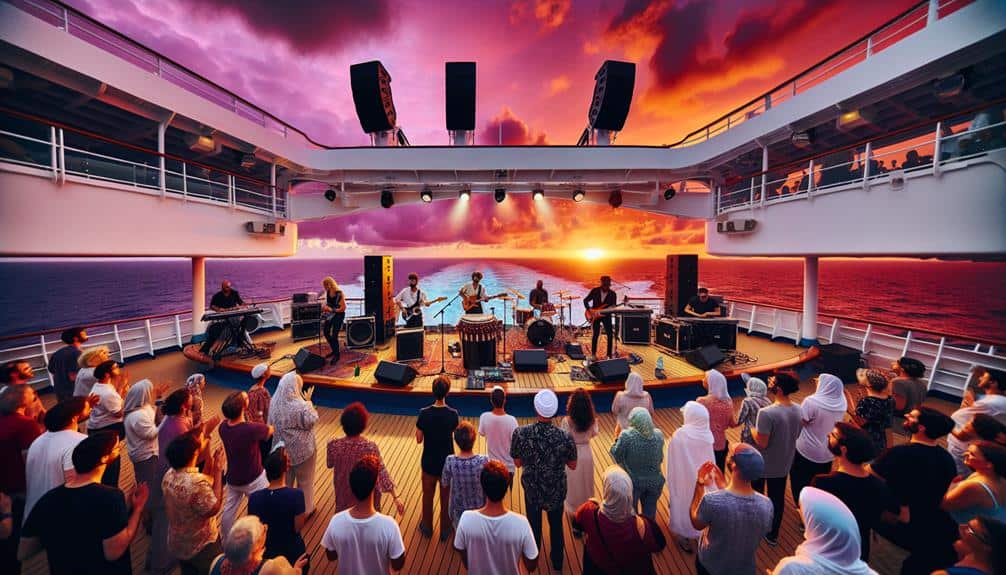Enhance your cruise ship's sound quality with these expert tips: Use advanced acoustic insulation, soundproof cabins, and install noise-canceling systems. Combat engine noise with insulation and alternative propeller designs. Upgrade audio equipment with high-quality speakers and processors. Design spaces with sound-absorbing materials and strategic placement. Optimize entertainment areas with strategic audio equipment placement and sound-absorbing materials. Master the art of sound management onboard for an immersive auditory experience.
Key Points
- Implement advanced acoustic insulation solutions like soundproof curtains and acoustic foam panels.
- Soundproof cabins and lounges using high-quality materials like mass loaded vinyl and acoustic panels.
- Install noise-canceling systems with upgraded windows and professional assessments for tailored solutions.
- Reduce engine noise through insulation materials, vibration dampening, and propeller design considerations.
- Enhance sound quality in entertainment areas by strategic placement of audio equipment and sound-absorbing materials.
Acoustic Insulation Solutions
To enhance sound quality on cruise ships, consider implementing advanced acoustic insulation solutions. Acoustic paneling solutions, such as soundproof curtains and acoustic foam panels, can markedly reduce noise levels in cabins and public areas. Utilizing noise-canceling headphones can also provide passengers with a more peaceful environment, especially in areas where complete sound isolation may not be possible.
Acoustic paneling solutions are designed to absorb and dampen sound waves, preventing them from bouncing off walls and creating echoes. Soundproof curtains, made from dense materials, can help block outside noise from entering cabins or lounges. Acoustic foam panels, strategically placed on walls or ceilings, can further enhance sound quality by minimizing reverberations and echoes.
Soundproofing Cabins and Lounges
Consider implementing advanced soundproofing techniques in cabins and lounges to enhance the overall acoustic environment onboard cruise ships. To achieve peak soundproofing, incorporate the following strategies:
- Use High-Quality Soundproofing Materials: Opt for materials like mass loaded vinyl, acoustic panels, and soundproof curtains to minimize sound transmission through walls, ceilings, and floors.
- Implement Interior Design Concepts: Utilize soft furnishings, carpets, and drapes to absorb sound and reduce echo within cabins and lounges.
- Seal Gaps and Cracks: Guarantee all gaps and cracks are sealed with soundproofing sealants to prevent sound leakage from entering or exiting the space.
- Install Double-Glazed Windows: Double-glazed windows provide an additional barrier against external noise, enhancing the soundproofing capabilities of cabins and lounges.
Installation of Noise-Canceling Systems
When considering the installation of noise-canceling systems on cruise ships, you'll focus on effective noise reduction, ensuring an enhanced passenger experience.
These systems incorporate advanced audio technology to actively counter ambient noise, elevating the overall sound quality onboard.
Effective Noise Reduction
Installing noise-canceling systems is an important step in achieving effective noise reduction on cruise ships. To enhance the noise reduction process, consider the following:
- Soundproof Windows: Upgrade existing windows with soundproof materials to minimize external noise infiltration.
- Acoustic Panels: Install acoustic panels strategically throughout the ship to absorb and reduce noise levels in common areas.
- Active Noise-Canceling Systems: Implement advanced noise-canceling technology to actively counteract unwanted sounds.
- Professional Assessment: Seek expert advice to conduct a thorough evaluation of the ship's acoustic environment and recommend tailored solutions for best noise reduction.
Enhanced Passenger Experience
Enhance the overall passenger experience by incorporating noise-canceling systems in key areas of the cruise ship. By strategically installing these systems in entertainment venues, relaxation areas, and cabins, passenger comfort is greatly elevated.
Noise reduction is essential for ensuring a peaceful environment where guests can unwind and enjoy the onboard entertainment without disturbances. Advanced noise-canceling technology utilizes sound wave interference to minimize unwanted ambient noise, creating a serene atmosphere for passengers to relax in.
This enhancement not only improves the quality of the onboard experience but also contributes to increased customer satisfaction levels. Implementing noise-canceling systems demonstrates a commitment to providing a premium cruise experience, where guests can fully immerse themselves in the entertainment offerings and find moments of tranquility during their voyage.
Advanced Audio Technology
To optimize sound quality on cruise ships, consider strategically integrating noise-canceling systems in key areas such as entertainment venues, relaxation areas, and cabins. When installing noise-canceling systems, adhere to advanced audio engineering techniques to guarantee high fidelity sound throughout the ship.
Here are four essential steps for implementing these systems effectively:
- Precise Speaker Placement: Position speakers strategically to achieve ideal sound distribution and clarity.
- Utilize Surround Sound Technology: Implement surround sound systems to create an immersive audio experience for passengers.
- Calibrate Noise-Canceling Systems: Fine-tune the settings of the noise-canceling systems to match the acoustics of each area accurately.
- Regular Maintenance: Conduct routine checks and maintenance to ensure the noise-canceling systems are functioning at their peak performance levels.
Engine Noise Reduction Techniques
When considering engine noise reduction techniques on cruise ships, focus on implementing insulation materials that effectively dampen sound waves and vibrations.
Explore advanced solutions for vibration dampening to minimize the transmission of noise throughout the ship.
Additionally, pay attention to propeller design considerations to reduce the overall noise generated by the engine system.
Insulation for Engine Noise
Minimize engine noise disturbance by implementing advanced insulation techniques designed specifically for cruise ships. When it comes to reducing engine noise on a cruise ship, the following steps can greatly improve sound quality:
- Utilize soundproofing materials such as mass loaded vinyl barriers to block airborne noise.
- Apply specialized acoustic foam to absorb sound waves and prevent reverberation.
- Install vibration isolation mounts to reduce structure-borne noise transmission.
- Seal any gaps or openings in the engine room to prevent noise leakage.
Vibration Dampening Solutions
Implementing effective vibration dampening solutions is essential for reducing engine noise levels on cruise ships and enhancing overall sound quality onboard. Vibration control techniques play a vital role in minimizing the transmission of engine vibrations to the structure of the ship.
One common method is the use of resilient mounts, which isolate the engine from the ship's framework, reducing the transfer of vibrations. Additionally, sound enhancement solutions like active noise cancellation systems can further improve the acoustic environment by emitting sound waves that counteract engine noise.
Damping materials such as rubber pads or acoustic foam can also be strategically placed to absorb vibrations and reduce noise propagation. By integrating these vibration dampening solutions, cruise ships can create a quieter and more enjoyable experience for passengers.
Propeller Design Considerations
Consider incorporating advanced propeller designs as part of the engine noise reduction techniques on cruise ships to greatly enhance sound quality for passengers. When focusing on propeller design for efficient propulsion and hydrodynamic efficiency, keep the following key considerations in mind:
- Blade Shape: Opt for blades with a design that minimizes cavitation, reducing noise levels.
- Material Selection: Choose materials that enhance durability while minimizing vibrations.
- Pitch Adjustment Mechanisms: Implement mechanisms for adjusting pitch to optimize performance and reduce noise.
- Tip Clearance: Maintain proper tip clearance to prevent noise caused by blade-tip vortex interactions.
Utilizing Advanced Audio Equipment
To enhance the sound quality on cruise ships, incorporating cutting-edge audio equipment is essential. Advanced audio equipment plays a significant role in achieving the best audio quality and ensuring a superior sound engineering experience for passengers. Utilizing high-quality speakers, amplifiers, and sound processors can greatly enhance the overall audio performance on a cruise ship.
Investing in state-of-the-art digital signal processors (DSPs) allows for precise control over audio signals, enabling sound engineers to fine-tune frequencies and tailor the sound to the specific acoustic characteristics of each venue onboard. Additionally, utilizing line array speaker systems can help distribute sound evenly throughout large spaces, minimizing audio inconsistencies and ensuring a more immersive listening experience for guests.
Furthermore, incorporating advanced mixing consoles with digital capabilities enables sound engineers to manage multiple audio sources seamlessly and make real-time adjustments to achieve the desired sound quality. By leveraging cutting-edge audio equipment, cruise ships can deliver a superior auditory experience that meets the expectations of discerning passengers.
Designing Sound-Friendly Spaces
Maximizing sound quality also involves carefully designing spaces on cruise ships to optimize acoustics for a superior auditory experience. When creating acoustically designed spaces, consider the following:
- Material Selection: Choose sound-absorbing materials like acoustic panels, carpets, and drapes to reduce sound reflections and echoes, enhancing the overall sound quality in the space.
- Room Shape: Design spaces with irregular shapes to prevent sound waves from bouncing back and creating unwanted reverberations, ensuring a clearer sound environment.
- Ceiling Treatments: Install acoustic ceiling tiles or treatments to minimize sound reflections from above, improving the overall acoustics of the space.
- Furniture Arrangement: Arrange furniture strategically to act as sound diffusers, breaking up sound waves and reducing the intensity of reflections for a more balanced sound distribution.
Enhancing Sound Quality in Entertainment Areas
Enhancing sound quality in entertainment areas requires strategic placement of audio equipment and acoustical treatments to create an immersive auditory experience for guests. Acoustic design plays an essential role in ensuring that sound is dispersed evenly throughout the space, minimizing echoes and unwanted noise. When setting up audio systems in these areas, consider factors such as the shape and size of the room, the materials used in construction, and the presence of any sound-reflective surfaces.
To achieve ideal audio optimization, start by conducting a thorough analysis of the space to identify potential acoustic challenges. Utilize tools like sound level meters to measure existing noise levels and frequency analyzers to pinpoint any areas with sound distortion. Implementing sound-absorbing materials like acoustic panels, carpets, and drapes can help dampen sound reflections and enhance overall sound quality.
Frequently Asked Questions
How Can Passengers Contribute to Improving Sound Quality on a Cruise Ship?
To enhance sound quality on a cruise ship, passengers can engage in noise control initiatives by respecting quiet zones, avoiding loud behavior, and providing feedback to the crew. Passenger involvement is essential for a serene environment.
Are There Any Regulations or Standards in Place for Sound Levels on Cruise Ships?
For cruise ships, noise pollution regulations are essential. Acoustic design and solutions play a pivotal role in meeting these standards. Adhering to specific sound levels guarantees a comfortable environment for passengers and compliance with maritime laws.
Can Sound Quality Be Improved Without Disrupting the Overall Aesthetic of the Ship's Design?
You can enhance sound quality on cruise ships without disrupting the ship's design. By integrating acoustic solutions strategically, achieving a balance between aesthetics and audio performance is attainable. Careful planning and implementation will guarantee a harmonious outcome.
What Are Some Common Challenges Faced When Trying to Enhance Sound Quality in Outdoor Areas on a Cruise Ship?
Improving sound quality in outdoor areas on a cruise ship poses challenges such as addressing outdoor acoustics and balancing design constraints. It's essential to explore entertainment options and collect guest feedback to fine-tune the audio experience.
How Do Cruise Ships Handle Soundproofing in Areas With High Foot Traffic or Frequent Use?
Enhancing sound quality on cruise ships requires strategic placement of acoustic paneling to dampen noise in high-traffic areas. Incorporating sound masking techniques and sound absorption materials can mitigate disturbances caused by foot traffic, ensuring a serene environment.




